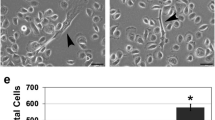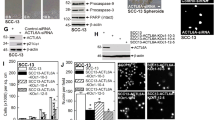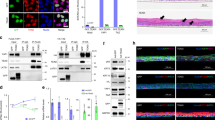Abstract
Epidermal growth factor receptor (EGFR) is central to epithelial cell physiology, and deregulated EGFR signaling has an important role in a variety of human carcinomas. Here we show that silencing of the EGF-related factor amphiregulin (AREG) markedly inhibits the expansion of human keratinocytes through mitotic failure and accumulation of cells with ⩾4n DNA content. RNA-sequencing-based transcriptome analysis revealed that tetracycline-mediated AREG silencing significantly altered the expression of 2331 genes, 623 of which were not normalized by treatment with EGF. Interestingly, genes irreversibly upregulated by suppression of AREG overlapped with genes involved in keratinocyte differentiation. Moreover, a significant proportion of the irreversibly downregulated genes featured upstream binding sites recognized by forkhead box protein M1 (FoxM1), a key transcription factor in the control of mitosis that is widely dysregulated in cancer. The downregulation of FoxM1 and its target genes preceded mitotic arrest. Constitutive expression of FoxM1 in AREG knockdown cells normalized cell proliferation, reduced the number of cells with ⩾4n DNA content and rescued expression of FoxM1 target genes. These results demonstrate that AREG controls G2/M progression and cytokinesis in keratinocytes via activation of a FoxM1-dependent transcriptional program, suggesting new avenues for treatment of epithelial cancer.
This is a preview of subscription content, access via your institution
Access options
Subscribe to this journal
Receive 50 print issues and online access
$259.00 per year
only $5.18 per issue
Buy this article
- Purchase on Springer Link
- Instant access to full article PDF
Prices may be subject to local taxes which are calculated during checkout









Similar content being viewed by others
Accession codes
Abbreviations
- AREG:
-
amphiregulin
- CFSE:
-
carboxyfluorescein succinimidyl ester
- DAPI:
-
4‘,6-diamidino-2-phenylindole
- DEG:
-
differentially expressed gene
- EGF:
-
epidermal growth factor
- EGFP:
-
enhanced green fluorescent protein
- EGFR:
-
EGF receptor
- ERK:
-
extracellular signal-regulated kinase
- FoxM1:
-
forkhead box protein M1
- GF:
-
growth factor
- HB-EGF:
-
heparin-binding EGF-like growth factor
- QRT–PCR:
-
quantitative real-time–polymerase chain reaction
- Tet:
-
tetracycline
- TGF-α:
-
transforming growth factor-α
References
Blanpain C, Fuchs E . Epidermal homeostasis: a balancing act of stem cells in the skin. Nat Rev Mol Cell Biol 2009; 10: 207–217.
Gandarillas A, Freije A . Cycling up the epidermis: reconciling 100 years of debate. Exp Dermatol 2014; 23: 87–91.
Murillas R, Larcher F, Conti CJ, Santos M, Ullrich A, Jorcano JL . Expression of a dominant negative mutant of epidermal growth factor receptor in the epidermis of transgenic mice elicits striking alterations in hair follicle development and skin structure. EMBO J 1995; 14: 5216–5223.
Miettinen PJ, Berger JE, Meneses J, Phung Y, Pedersen RA, Werb Z et al. Epithelial immaturity and multiorgan failure in mice lacking epidermal growth factor receptor. Nature 1995; 376: 337–341.
Sibilia M, Wagner EF . Strain-dependent epithelial defects in mice lacking the EGF receptor [published erratum appears in Science 1995; 269(5226): 909]. Science 1995; 269: 234–238.
Threadgill DW, Dlugosz AA, Hansen LA, Tennenbaum T, Lichti U, Yee D et al. Targeted disruption of mouse EGF receptor: effect of genetic background on mutant phenotype. Science 1995; 269: 230–234.
Stoll SW, Johnson JL, Bhasin A, Johnston A, Gudjonsson JE, Rittie L et al. Metalloproteinase-mediated, context-dependent function of amphiregulin and HB-EGF in human keratinocytes and skin. J Invest Dermatol 2010; 130: 295–304.
Kansra S, Stoll SW, Johnson JL, Elder JT . Src family kinase inhibitors block amphiregulin-mediated autocrine ErbB signaling in normal human keratinocytes. Mol Pharmacol 2005; 67: 1145–1157.
Stoll SW, Johnson JL, Li Y, Rittie L, Elder JT . Amphiregulin carboxy-terminal domain is required for autocrine keratinocyte growth. J Invest Dermatol 2010; 130: 2031–2040.
Boonstra J, De Laat SW, Ponec M . Epidermal growth factor receptor expression related to differentiation capacity in normal and transformed keratinocytes. Exp Cell Res 1985; 161: 421–433.
Poumay Y, Pittelkow MR . Cell density and culture factors regulate keratinocyte commitment to differentiation and expression of suprabasal K1/K10 keratins. J Invest Dermatol 1995; 104: 271–276.
Peus D, Hamacher L, Pittelkow MR . EGF-receptor tyrosine kinase inhibition induces keratinocyte growth arrest and terminal differentiation. J Invest Dermatol 1997; 109: 751–756.
Stoll SW, Benedict M, Mitra R, Hiniker A, Elder JT, Nuñez G . EGF receptor signaling inhibits keratinocyte apoptosis: evidence for mediation by Bcl-XL. Oncogene 1998; 16: 1493–1499.
Jost M, Class R, Kari C, Jensen PJ, Rodeck U . A central role of Bcl-X(L) in the regulation of keratinocyte survival by autocrine EGFR ligands. J Invest Dermatol 1999; 112: 443–449.
Mascia F, Lam G, Keith C, Garber C, Steinberg SM, Kohn E et al. Genetic ablation of epidermal EGFR reveals the dynamic origin of adverse effects of anti-EGFR therapy. Sci Transl Med 2013; 5: 199ra110.
Lichtenberger BM, Gerber PA, Holcmann M, Buhren BA, Amberg N, Smolle V et al. Epidermal EGFR controls cutaneous host defense and prevents inflammation. Sci Transl Med 2013; 5: 199ra111.
Johnston A, Gudjonsson JE, Aphale A, Guzman AM, Stoll SW, Elder JT . EGFR and IL-1 signaling synergistically promote keratinocyte antimicrobial defenses in a differentiation-dependent manner. J Invest Dermatol 2011; 131: 329–337.
Yarden Y, Pines G . The ERBB network: at last, cancer therapy meets systems biology. Nat Rev Cancer 2012; 12: 553–563.
Yoshida T, Zhang G, Haura EB . Targeting epidermal growth factor receptor: Central signaling kinase in lung cancer. Biochem Pharmacol 2010; 80: 613–623.
Jean GW, Shah SR . Epidermal growth factor receptor monoclonal antibodies for the treatment of metastatic colorectal cancer. Pharmacotherapy 2008; 28: 742–754.
Chen LF, Cohen EE, Grandis JR . New strategies in head and neck cancer: understanding resistance to epidermal growth factor receptor inhibitors. Clin Cancer Res 2010; 16: 2489–2495.
Tebbutt N, Pedersen MW, Johns TG . Targeting the ERBB family in cancer: couples therapy. Nat Rev Cancer 2013; 13: 663–673.
Sanderson MP, Dempsey PJ, Dunbar AJ . Control of ErbB signaling through metalloprotease mediated ectodomain shedding of EGF-like factors. Growth Factors 2006; 24: 121–136.
Rittie L, Kansra S, Stoll SW, Li Y, Gudjonsson JE, Shao Y et al. Differential ErbB1 signaling in squamous cell versus basal cell carcinoma of the skin. Am J Pathol 2007; 170: 2089–2099.
Robertson ED, Weir L, Romanowska M, Leigh IM, Panteleyev AA . ARNT controls the expression of epidermal differentiation genes through HDAC- and EGFR-dependent pathways. J Cell Sci 2012; 125: 3320–3332.
Sternlicht MD, Sunnarborg SW . The ADAM17-amphiregulin-EGFR axis in mammary development and cancer. J Mammary Gland Biol Neoplasia 2008; 13: 181–194.
Qin L, Tamasi J, Raggatt L, Li X, Feyen JH, Lee DC et al. Amphiregulin is a novel growth factor involved in normal bone development and in the cellular response to parathyroid hormone stimulation. J Biol Chem 2005; 280: 3974–3981.
Kansra S, Stoll SW, Johnson JL, Elder JT . Autocrine extracellular signal-regulated kinase (ERK) activation in normal human keratinocytes: metalloproteinase-mediated release of amphiregulin triggers signaling from ErbB1 to ERK. Mol Biol Cell 2004; 15: 4299–4309.
Schelfhout VR, Coene ED, Delaey B, Waeytens AA, De Rycke L, Deleu M et al. The role of heregulin-alpha as a motility factor and amphiregulin as a growth factor in wound healing. J Pathol 2002; 198: 523–533.
Stoll S, Garner W, Elder J . Heparin-binding ligands mediate autocrine epidermal growth factor receptor activation In skin organ culture. J Clin Invest 1997; 100: 1271–1281.
Fontanini G, De Laurentiis M, Vignati S, Chine S, Lucchi M, Silvestri V et al. Evaluation of epidermal growth factor-related growth factors and receptors and of neoangiogenesis in completely resected stage I-IIIA non-small-cell lung cancer: amphiregulin and microvessel count are independent prognostic indicators of survival. Clin Cancer Res 1998; 4: 241–249.
Busser B, Sancey L, Brambilla E, Coll JL, Hurbin A . The multiple roles of amphiregulin in human cancer. Biochim Biophys Acta 2011; 1816: 119–131.
Rhodes DR, Kalyana-Sundaram S, Mahavisno V, Varambally R, Yu J, Briggs BB et al. Oncomine 3.0: genes, pathways, and networks in a collection of 18,000 cancer gene expression profiles. Neoplasia 2007; 9: 166–180.
Tinhofer I, Klinghammer K, Weichert W, Knodler M, Stenzinger A, Gauler T et al. Expression of amphiregulin and EGFRvIII affect outcome of patients with squamous cell carcinoma of the head and neck receiving cetuximab-docetaxel treatment. Clin Cancer Res 2011; 17: 5197–5204.
Laoukili J, Stahl M, Medema RH . FoxM1: at the crossroads of ageing and cancer. Biochim Biophys Acta 2007; 1775: 92–102.
Laoukili J, Kooistra MR, Bras A, Kauw J, Kerkhoven RM, Morrison A et al. FoxM1 is required for execution of the mitotic programme and chromosome stability. Nat Cell Biol 2005; 7: 126–136.
Falcon S, Gentleman R . Using GOstats to test gene lists for GO term association. Bioinformatics 2007; 23: 257–258.
Sadasivam S, Duan S, DeCaprio JA . The MuvB complex sequentially recruits B-Myb and FoxM1 to promote mitotic gene expression. Genes Dev 2012; 26: 474–489.
Down CF, Millour J, Lam EW, Watson RJ . Binding of FoxM1 to G2/M gene promoters is dependent upon B-Myb. Biochim Biophys Acta 2012; 1819: 855–862.
Fontijn RD, Goud B, Echard A, Jollivet F, van Marle J, Pannekoek H et al. The human kinesin-like protein RB6K is under tight cell cycle control and is essential for cytokinesis. Mol Cell Biol 2001; 21: 2944–2955.
Wang H, Teh MT, Ji Y, Patel V, Firouzabadian S, Patel AA et al. EPS8 upregulates FOXM1 expression, enhancing cell growth and motility. Carcinogenesis 2010; 31: 1132–1141.
Yang G, Chang B, Yang F, Guo X, Cai KQ, Xiao XS et al. Aurora kinase A promotes ovarian tumorigenesis through dysregulation of the cell cycle and suppression of BRCA2. Clin Cancer Res 2010; 16: 3171–3181.
Lens SM, Medema RH . The survivin/Aurora B complex: its role in coordinating tension and attachment. Cell Cycle 2003; 2: 507–510.
Raychaudhuri P, Park HJ . FoxM1: a master regulator of tumor metastasis. Cancer Res 2011; 71: 4329–4333.
Okabe H, Satoh S, Kato T, Kitahara O, Yanagawa R, Yamaoka Y et al. Genome-wide analysis of gene expression in human hepatocellular carcinomas using cDNA microarray: identification of genes involved in viral carcinogenesis and tumor progression. Cancer Res 2001; 61: 2129–2137.
Pilarsky C, Wenzig M, Specht T, Saeger HD, Grutzmann R . Identification and validation of commonly overexpressed genes in solid tumors by comparison of microarray data. Neoplasia 2004; 6: 744–750.
Teh MT, Wong ST, Neill GW, Ghali LR, Philpott MP, Quinn AG . FOXM1 is a downstream target of Gli1 in basal cell carcinomas. Cancer Res 2002; 62: 4773–4780.
Xue J, Lin X, Chiu WT, Chen YH, Yu G, Liu M et al. Sustained activation of SMAD3/SMAD4 by FOXM1 promotes TGF-beta-dependent cancer metastasis. J Clin Invest 2014; 124: 564–579.
Kong X, Li L, Li Z, Le X, Huang C, Jia Z et al. Dysregulated expression of FOXM1 isoforms drives progression of pancreatic cancer. Cancer Res 2013; 73: 3987–3996.
Alvarez-Fernandez M, Medema RH . Novel functions of FoxM1: from molecular mechanisms to cancer therapy. Front Oncol 2013; 3: 30.
Chandler H, Peters G . Stressing the cell cycle in senescence and aging. Curr Opin Cell Biol 2013; 25: 765–771.
Dickson MA, Hahn WC, Ino Y, Ronfard V, Wu JY, Weinberg RA et al. Human keratinocytes that express hTERT and also bypass a p16(INK4a)-enforced mechanism that limits life span become immortal yet retain normal growth and differentiation characteristics. Mol Cell Biol 2000; 20: 1436–1447.
Serrano M, Lee H, Chin L, Cordon-Cardo C, Beach D, DePinho RA . Role of the INK4a locus in tumor suppression and cell mortality. Cell 1996; 85: 27–37.
Okamoto A, Demetrick DJ, Spillare EA, Hagiwara K, Hussain SP, Bennett WP et al. Mutations and altered expression of p16INK4 in human cancer. Proc Natl Acad Sci USA Am 1994; 91: 11045–11049.
Ma RY, Tong TH, Cheung AM, Tsang AC, Leung WY, Yao KM . Raf/MEK/MAPK signaling stimulates the nuclear translocation and transactivating activity of FOXM1c. J Cell Sci 2005; 118: 795–806.
Laoukili J, Alvarez-Fernandez M, Stahl M, Medema RH . FoxM1 is degraded at mitotic exit in a Cdh1-dependent manner. Cell Cycle 2008; 7: 2720–2726.
Leung TW, Lin SS, Tsang AC, Tong CS, Ching JC, Leung WY et al. Over-expression of FoxM1 stimulates cyclin B1 expression. FEBS Lett 2001; 507: 59–66.
Yao KM, Sha M, Lu Z, Wong GG . Molecular analysis of a novel winged helix protein, WIN. Expression pattern, DNA binding property, and alternative splicing within the DNA binding domain. J Biol Chem 1997; 272: 19827–19836.
Hennings H, Michael D, Cheng C, Steinert P, Holbrook K, Yuspa SH . Calcium regulation of growth and differentiation of mouse epidermal cells in culture. Cell 1980; 19: 245–254.
Liu B, Xia X, Zhu F, Park E, Carbajal S, Kiguchi K et al. IKKalpha is required to maintain skin homeostasis and prevent skin cancer. Cancer Cell 2008; 14: 212–225.
Wonsey DR, Follettie MT . Loss of the forkhead transcription factor FoxM1 causes centrosome amplification and mitotic catastrophe. Cancer Res 2005; 65: 5181–5189.
Edgar BA, Orr-Weaver TL . Endoreplication cell cycles: more for less. Cell 2001; 105: 297–306.
Schuller U, Zhao Q, Godinho SA, Heine VM, Medema RH, Pellman D et al. Forkhead transcription factor FoxM1 regulates mitotic entry and prevents spindle defects in cerebellar granule neuron precursors. Mol Cell Biol 2007; 27: 8259–8270.
Freije A, Ceballos L, Coisy M, Barnes L, Rosa M, De Diego E et al. Cyclin E drives human keratinocyte growth into differentiation. Oncogene 2012; 31: 5180–5192.
Zanet J, Freije A, Ruiz M, Coulon V, Sanz JR, Chiesa J et al. A mitosis block links active cell cycle with human epidermal differentiation and results in endoreplication. PLoS ONE 2010; 5: e15701.
Stoll SW, Stuart PE, Lambert S, Rittie L, Johnston A, Nair RP et al. The C-terminal domain of amphiregulin promotes G2/M progression in human keratinocytes. J Invest Dermatol 2015 (submitted).
Trapnell C, Pachter L, Salzberg SL . TopHat: discovering splice junctions with RNA-Seq. Bioinformatics 2009; 25: 1105–1111.
Garber M, Grabherr MG, Guttman M, Trapnell C . Computational methods for transcriptome annotation and quantification using RNA-seq. Nat Methods 2011; 8: 469–477.
Robinson MD, McCarthy DJ, Smyth GK . edgeR: a Bioconductor package for differential expression analysis of digital gene expression data. Bioinformatics 2010; 26: 139–140.
Benjamini Y, Hochberg Y . Controlling the false positive discovery rate: a practical and powerful approach to multiple testing. J R Stat Soc Ser B 1995; 57: 289–300.
Ashburner M, Ball CA, Blake JA, Botstein D, Butler H, Cherry JM et al. Gene ontology: tool for the unification of biology. The Gene Ontology Consortium. Nat Genet 2000; 25: 25–29.
Kanehisa M, Goto S, Sato Y, Furumichi M, Tanabe M . KEGG for integration and interpretation of large-scale molecular data sets. Nucleic Acids Res 2012; 40: D109–D114.
Matthews L, Gopinath G, Gillespie M, Caudy M, Croft D, de Bono B et al. Reactome knowledgebase of human biological pathways and processes. Nucleic Acids Res 2009; 37: D619–D622.
Yu G Reactome PA: Reactome Pathway Analysis. R package version 1.10.0 2015, Available at http://bioconductor.org/packages/release/data/annotation/html/reactome.db.html.
Swindell WR, Johnston A, Xing X, Little A, Robichaud P, Voorhees JJ et al. Robust shifts in S100a9 expression with aging: a novel mechanism for chronic inflammation. Scientific Rep 2013; 3: 1215.
Swindell WR, Johnston A, Xing X, Voorhees JJ, Elder JT, Gudjonsson JE . Modulation of epidermal transcription circuits in psoriasis: new links between inflammation and hyperproliferation. PLoS ONE 2013; 8: e79253.
Xie Z, Hu S, Blackshaw S, Zhu H, Qian J . hPDI: a database of experimental human protein–DNA interactions. Bioinformatics 2010; 26: 287–289.
Swindell WR, Stuart PE, Sarkar MK, Voorhees JJ, Elder JT, Johnston A et al. Cellular dissection of psoriasis for transcriptome analyses and the post-GWAS era. BMC Med Genom 2014; 7: 27.
Cumming G, Fidler F, Vaux DL . Error bars in experimental biology. J Cell Biol 2007; 177: 7–11.
Lazic SE . The problem of pseudoreplication in neuroscientific studies: is it affecting your analysis? BMC Neurosci 2010; 11: 5.
Maxwell SE, Delaney HD . Designing Experiments and Analyzing Data: A Model Comparison Perspective, 2nd edn. Psychology Press: New York, NY, USA; London, UK, 2004, p 868.
Morey RD . Confidence intervals from normalized data: a correction to Cousineau (2005). Tutor Quant Methods Psychol 2008; 4: 61–64.
Cousineau D . Confidence intervals in within-subject designs: a simpler solution to Loftus and Masson’s method. Tutor Quant Methods Psychol 2005; 1: 42–45.
Loftus GR, Masson ME . Using confidence intervals in within-subject designs. Psychonom Bull Rev 1994; 1: 476–490.
Gruenbaum Y, Wilson KL, Harel A, Goldberg M, Cohen M . Review: nuclear lamins—structural proteins with fundamental functions. J Struct Biol 2000; 129: 313–323.
Bonnard M, Mirtsos C, Suzuki S, Graham K, Huang J, Ng M et al. Deficiency of T2K leads to apoptotic liver degeneration and impaired NF-kappaB-dependent gene transcription. EMBO J 2000; 19: 4976–4985.
Acknowledgements
We thank Mahdu Prasad for assistance with RNA-seq assays and Dr James Rheinwald (Harvard Medical School, Boston, MA) for providing the N/TERT-2G keratinocyte cell line. This work was in part supported by the National Institute for Arthritis, Musculoskeletal and Skin Disease (NIAMS), National Institutes of Health (NIH award K01 AR050462 and R03 AR049420 to SWS, K01 AR064765 to AJ and R01 AR052889 to JTE) and Instituto de Salud Carlos III (Spain, ISCIII-FIS/FEDER, PI11/02070, to AG). AJ is supported by a Babcock Foundation Endowment. JTE is supported by the Ann Arbor Veterans Affairs Hospital.
Author information
Authors and Affiliations
Corresponding author
Ethics declarations
Competing interests
The authors declare no conflict of interest.
Additional information
Supplementary Information accompanies this paper on the Oncogene website
Supplementary information
Rights and permissions
About this article
Cite this article
Stoll, S., Stuart, P., Swindell, W. et al. The EGF receptor ligand amphiregulin controls cell division via FoxM1. Oncogene 35, 2075–2086 (2016). https://doi.org/10.1038/onc.2015.269
Received:
Revised:
Accepted:
Published:
Issue Date:
DOI: https://doi.org/10.1038/onc.2015.269
This article is cited by
-
IL-33-ST2 axis regulates myeloid cell differentiation and activation enabling effective club cell regeneration
Nature Communications (2020)
-
Glyceollins trigger anti-proliferative effects through estradiol-dependent and independent pathways in breast cancer cells
Cell Communication and Signaling (2017)
-
FOXM1 allows human keratinocytes to bypass the oncogene-induced differentiation checkpoint in response to gain of MYC or loss of p53
Oncogene (2017)
-
Exocrine Gland Morphogenesis: Insights into the Role of Amphiregulin from Development to Disease
Archivum Immunologiae et Therapiae Experimentalis (2017)



